Reading Time: 9 minutes
To those who know me from a distance, the idea that I have a ‘Wild Side’ is inconceivable. But those who know me will know that my ‘Wild Side, literally, belongs to the wild.
My love with nature began when I was a young girl. Vacation meant travel to wildlife sanctuaries. This awoke in my young heart a thirst that has not yet quenched.
Ranthambhore National Park, located in the heart of Rajasthan, India, is a mesmerising sanctuary that never fails to capture the essence of untamed beauty and wildlife majesty. As I pen down my thoughts about this enchanting haven, I am filled with a profound love and admiration for the park which has woven its magic into my heart.
The history of Ranthambore National Park can be traced back to the 10th Century when it served as a hunting ground for the Maharaja’s of Jaipur.
In 1980, it was designated as a National Park and this is the place where the revival of the tiger in India began- with the ’Project Tiger’ initiative. Besides the historic Ranthambore Fort, a UNESCO World Heritage site, which stands within its boundaries, it is renowned for its thriving tiger population. Its sprawling landscapes dotted with ancient ruins and lush greenery, offer a breathtaking backdrop to the incredible diversity of flora and fauna that call this place their home.


In the following pages, I shall embark on a journey to share a few captivating tales that have unfolded within the realm of Ranthambhore National Park. Through my words and photographs, I aim to bring to life some special moments that I have experienced in this magnificent wilderness. As I weave these stories, I hope to transport you into the heart of Ranthambhore, allowing you to feel the thrill of every sighting, the serenity of every dawn, and the awe inspiring harmony of nature’s symphony. It is my deep hope that my narratives and images serve as a testament to the allure of Ranthambhore, and inspire you to appreciate and protect this treasure trove of nature’s wonder.
Mother’s Love
The cutest sight is to see little cubs. It was a warm afternoon and as we drove along, we were hoping to get a glimpse of a tiger family we had spotted earlier. I imagined they’d gone much deeper into the woods, but our ranger spotted the tigress pop her head out of the bushes from behind us, as if to check if it were safe for her precious cubs to cross. After giving us the customary steely stare-down, and realising that we were mere admirers, she disappeared into the bushes again. This time, momentarily.


She returned with her clan: her cubs were no more than a few months old. It made me realise that a mother’s instinct of protecting her young, is one of the few emotions that permeates over every species, no matter how fierce.

The summers are an unforgiving time. Not only is water scarce and the heat inconsiderate, but danger often lurks at every step. This herd of Sambars had taken every precaution possible, before plunging themselves into the lake. Even the waters, mind you, are infested with giant killers, but this family seemed to be fortune’s favourite.

An inhabitant of Planet Earth for over 200 million years, the Marsh Crocodile is a member of Time’s ‘ultimate survivor’ stories. Unarguably the most fierce predator, in water or on land, crocs have outlived dinosaurs by 65 million years!

We spotted this jackal at a small watering hole cautiously quenching his thirst. What struck me was the beautiful picture he made. His reflection in the water was clear. While his eyes stared at us, his reflection seemed to stare straight back at him!
Sibling Rivalry
One evening, we saw this young tiger, who while following his prey, had strayed into his brother’s territory.

Having made a kill, he was fully aware that his stronger sibling would rightfully stake his claim. So he began his efforts to hide the trophy… but as he sensed his big brother’s proximity his attempts got more desperate, ultimately leading to a rather childlike “let-me-sit-on-it….so-he-can’t-find-a-thing” manoeuvre!

The elder brother seemed to stay away’ but moments later, we found him standing on a hill, basking in the golden evening light, displaying his majestic charm. He let out an almighty roar announcing to every creature of the wild that it was he who reigned there.

An “I-scratch-your-back, you-scratch-mine” session in progress. Bonding in langurs often happens over extended grooming sessions such as these.
The hunter becomes the hunted
The forest is not devoid of a sense of humour. We were privy to a truly comic episode. It was a cold foggy winter morning. On entering the park, we immediately chanced upon this young tiger, T85-Pacman, on his morning rounds. We went a little ahead to try and get some head shots as he approached us. But as we turned the corner, we saw a sloth bear. We held our breaths to see what would happen when the tiger encountered the black bear.

This young enthusiastic tiger chased the bear into the bushes. Moments later, we witness the hunter becoming the hunted! The burly sloth had turned the tables… the tiger, evidently, did not quite enjoy a taste of his own medicine!


The young male chose to ease his nerves, and get his breath back with a sip of refreshing water.
My Feathered Friends of Ranthambore

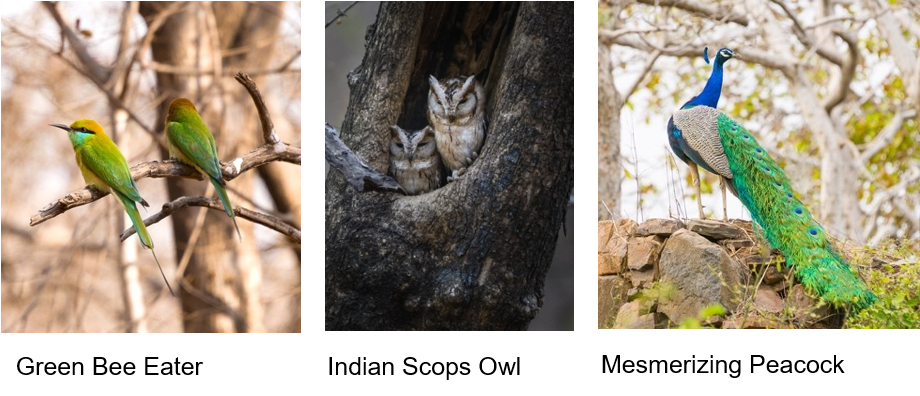
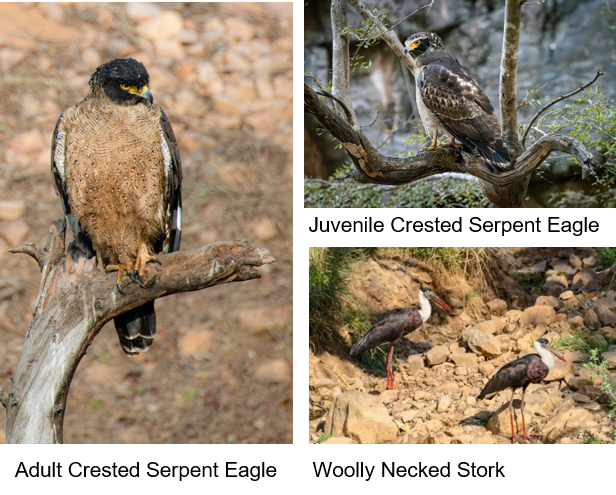
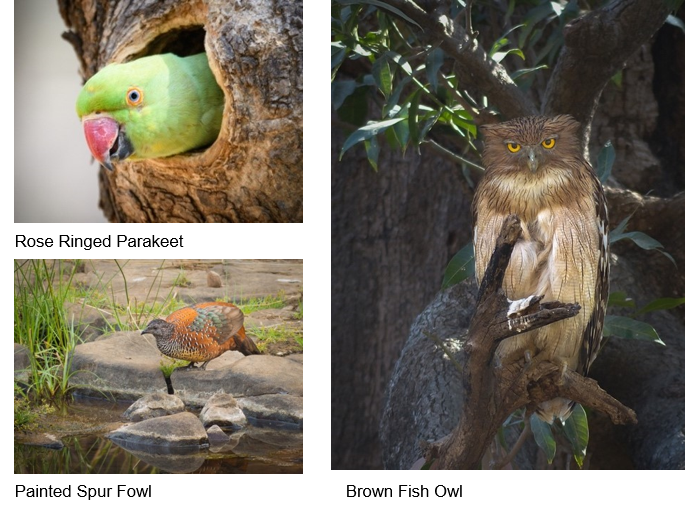

Typically shy, Sambars are not known to pose for the camera. Not in Ranthambore though. The Sambars here are more than happy to oblige. Seen here: A MODEL IN THE MAKING. This young calf, an outstanding student, took no time to shed her inhibitions and strike a pose.
Hunting is not child’s play. More so, when you are a tiger that weighs two hundred kilograms! Ironically, the jungle’s most prolific killer also bears the uncomplimentary average of one successful kill to fourteen foiled attempts!

Here we see young tigress T-83 Lightening, who is the daughter of T-19 Krishna after an unsuccessful hunt.

T-19 also known as Unnis or Krishna, was the queen of Ranthambore National Park and the daughter of the famous Machli. Here she is seen taking a dip with her three cubs on a hot summer’s afternoon.

The Grey Langur, with its darker face and hands, and almost human mannerisms is a throwback to the times of the Ramayan, which is why he is also known as ‘The Hanuman Monkey’.

The langurs share a famous bonhomie with the Chital Deer (spotted Deer). The monkey uses his sharp eyesight and vantage point to spot approaching danger, and the deer uses its sense of smell to return the favour.

The largest antelope in Asia – The Blue Bull or ‘Neelgai’ – is born greyish – brown and assumes his full blue glory when he reaches the prime of his youth. This young bull here was well and truly on his way there it seemed.

A young leopard looking down at us from his vantage perch on the tree. Unlike the African leopards, Indian ones are extremely shy and difficult to photograph.
Circle of Life
In the tranquil morning light, our gaze fell upon the elegant feline figure of T39,Noor. Her golden coat shimmered in the gentle rays as she moved gracefully, her eyes filled with determination. The day had started on a disappointing note for her, having lost a potential kill, but fate had a different plan in store.
As evening cast, its enchanting hues across the landscape, a male sambhar wandered unknowingly into the path of destiny. Oblivious to the imminent danger, he grazed peacefully, unaware of the predator closing in on him.

Noor a master of stealth, meticulously stalked her prey, her every step calculated and purposeful.
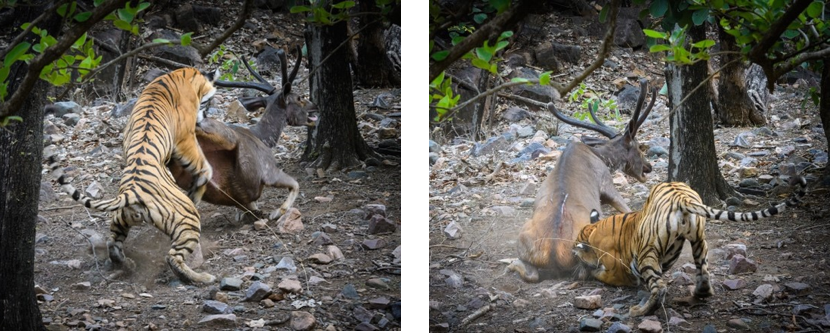
With a swift and calculated pounce, her powerful jaws and paws descended upon the unsuspecting sambar, bringing him down with a mix of raw strength and primal instinct.
 Having successfully killed her prey and secured her meal, Noor’s maternal instincts stirred within her. She had left behind three precious cubs, hungry and awaiting her return. With the sambar’s scent still lingering in the air, she made her way back to the spot where she had parted ways with her little ones. A roar, a mother’s call echoed through the forest, reaching the ears of her eager cubs.
Having successfully killed her prey and secured her meal, Noor’s maternal instincts stirred within her. She had left behind three precious cubs, hungry and awaiting her return. With the sambar’s scent still lingering in the air, she made her way back to the spot where she had parted ways with her little ones. A roar, a mother’s call echoed through the forest, reaching the ears of her eager cubs.

Responding to their mother’s call, the cubs emerged from their hiding place, their youthful exuberance on display. They scampered towards Noor, filled with excitement and hunger. With loving eyes, Noor greeted her cubs, relishing their presence. It was time for their nourishment, and together they set off towards the feast that awaited them.
In witnessing the sambar’s fate, a mix of emotions flooded over me. Sadness welled within, for the loss of a majestic creature’s life. But amidst that melancholy, a deeper realisation took hold. This was the circle of life, where one animal’s loss became another’s gain. Nature, with it’s intricate tapestry of existence, always found its own equilibrium.
In that moment, I acknowledged the delicate balance that governed the wilderness. It was a testament to the resilience of all living beings. And as Noor and her cubs disappeared into the forest, I carried with me a newfound appreciation for the raw beauty and unfathomable complexities of the natural world.
As the tale of Noor and her cubs fades into the depths of the jungle, a sense of awe lingers in the air. The wild has a way of capturing our hearts, igniting a flame of passion and love for its untamed beauty.
Ranthambhore, with it’s untamed wilderness and captivating stories, has woven it’s magic into my heart. The wild has become a sanctuary where I find peace, solace, harmony and a profound connection with divinity. The jungle and it’s inhabitants have taught me invaluable lessons about the delicate balance of nature and the interconnectedness of all living beings. As I immerse myself in the serenity of Ranthambhore, I am reminded of the need to protect and preserve these precious treasures that nature has bestowed upon us.
The love for Ranthambhore runs deep within me, as it does in the hearts of countless others who have ventured into it’s lush depths. It is here that we witness the symphony of life, where rustling leaves and majestic creatures become our teachers.
Let us continue to cherish this wild haven, and may love for it inspire us to be guardians of its wonders, ensuring that future generations can also experience the awe-inspiring beauty that lies within its untamed embrace.
Photographs by Urvi Piramal



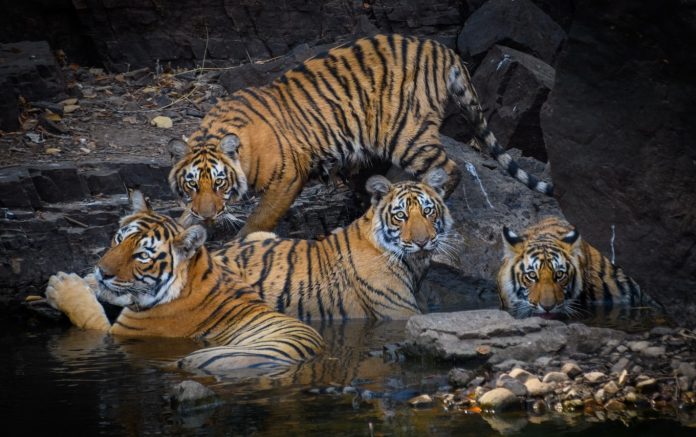





This is the best article on any wildlife sanctuary I have read. Thank you, Author.